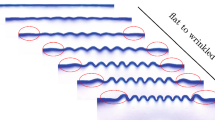Abstract
This work addresses the wrinkling of thin shells and membranes by stackable solid shells developed by our group. Formulation is now equipped with constitutive-based thickness extensibility. Both tension and shearing deformation modes are considered. The solid-shell formulation follows our previous work, with assumed natural shear strains and assumed in-plane stresses with condensed-out stress parameters. In addition, a combined finite strain plasticity constitutive/element framework is adopted, with the details concerning integration and null stress components being described. Four examples are presented with excellent results from the point of view of accuracy and realism. Specifically, a bilayer problem is solved with high accuracy with respect to experimental measurements, which would be difficult to address with classical shell or membrane formulations. Overall, the reduced constitutive law and the solid shell is applicable to problems that otherwise would require dedicated formulations.















Similar content being viewed by others
References
Flynn CO, McCormack BAO (2009) A three-layer model of skin and its application in simulating wrinkling. Comput Methods Biomech Biomed Eng Imaging Vis 12(2):125–134
Feng W, Yu Y, Kim B (2010) A deformation transformer for real-time cloth animation. ACM Trans Gr 29(4):108
Vladimirov I, Pietryga MP, Reese S (2010) Anisotropic finite elastoplasticity with nonlinear kinematic and isotropic hardening and application to sheet metal forming. Int J Plast 26:659–687
Abdelkhalek S, Zahrouni H, Legrand N, Potier-Ferry M (2015) Post-buckling modeling for strips under tension and residual stresses under asymptotic numerical method. Int J Mech Sci 104:126–137
Silvestre N (2016) Wrinkling of stretched thin sheets: is restrained Poisson’s effect the sole cause? Eng Struct 106:195–208
Friedl N, Rammerstorfer FG, Fischer FD (2000) Buckling of stretched strips. Comput Struct 78(1–3):185–190
Nayyar V, Ravi-Chandar K, Huang R (2011) Stretch-induced stress patterns and wrinkles in hyperelastic thin sheets. Int J Solids Struct 48:3471–3483
Healey TJ, Li Q, Cheng R-B (2013) Wrinkling behavior of highly stretched rectangular elastic films via parametric global bifurcation. J Nonlinear Sci 23:777–805
Fu C, Wang T, Xu F, Huo Y, Potier-Ferry M (2019) A modeling and resolution framework for wrinkling in hyperelastic sheets at finite membrane strain. J Mech Phys Solids 124:446–470
Cochelin B, Damil N, Potier-Ferry M (1994) Asymptotic-numerical methods and Padé approximants for non-linear elastic structures. Int J Numer Methods Eng 37(7):1187–1213
Li Q, Healey TJ (2016) Stability boundaries for wrinkling in highly stretched elastic sheets. J Mech Phys Solids 97:260–274
Taylor M, Bertoldi K, Steigmann DJ (2014) Spatial resolution of wrinkle patterns in thin elastic sheets at finite strain. J Mech Phys Solids 62:163–180
Areias P, Mota Soares CA, Rabczuk T, Garção J (2016) A finite-strain solid-shell using local Löwdin frames and least-squares strains. Comput Method Appl Mech 311:112–133
Bathe K-J, Dvorkin EN (1986) A formulation of general shell elements—the use of mixed interpolation of tensorial components. Int J Numer Methods Eng 22:697–722
Dvorkin E, Bathe KJ (1984) A continuum mechanics based four node shell element for general nonlinear analysis. Eng Comput 1:77–88
Areias P, Rabczuk T, César de Sá J, Natal Jorge R (2015) A semi-implicit finite strain shell algorithm using in-plane strains based on least-squares. Comput Mech 55(4):673–696
Wolfram Research Inc (2021) Mathematica 13.0.0, Champaign, Illinois. https://www.wolfram.com/mathematica. Accessed 04 Oct 2021
Korelc J (2002) Multi-language and multi-environment generation of nonlinear finite element codes. Eng Comput 18(4):312–327
Mandel J (1973) Equations constitutives et directeurs dans les milieux plastiques et viscoplastiques. Int J Solids Struct 9:725–740
Andelfinger U, Ramm E (1993) EAS-elements for two-dimensional, three-dimensional, plate and shell structures and their equivalence to HR-elements. Int J Numer Methods Eng 36:1311–1337
Buchter N, Ramm E, Roehl D (1994) Three-dimensional extension of nonlinear shell formulation based on the enhanced assumed strain concept. Int J Numer Methods Eng 37:2551–3568
Eidel B, Gruttmann F (2003) Elastoplastic orthotropy at finite strains: multiplicative formulation and numerical implementation. Comput Mater Sci 28:732–742
Kröner E (1960) Allgemeine kontinuumstheorie der versetzungen und eigenspannungen. Arch Ration Mech Anal 4:273–334
Lee EH (1969) Elasto-plastic deformation at finite strains. J Appl Mech ASME 36:1–6
Lubliner J (1990) Plasticity theory. MacMillan, New York
Gurtin ME (1981) An introduction to continuum mechanics, volume 158 of mathematics in science and engineering. Academic Press, New York
Mandel J (1974) Foundations of continuum thermodynamics, chapter thermodynamics and plasticity. MacMillan, London, pp 283–304
Hill R (1948) A theory of yielding and plastic flow of anisotropic metals. Proc R Soc Lond 193:281–297
Areias PS. Portuguese Software Association (ASSOFT) registry number 2281/D/17. http://www.simplassoftware.com. Accessed 11 Oct 2021
DuPont de Nemours, Inc, Wilmington, Delaware, USA (2018) Dupont™ Kapton HN polyimide film. Technical report
Wong WY, Pellegrino S (2006) Wrinkled membranes part I: experiments. J Mech Mater Struct 1(1):3
Wong YW, Pellegrino S (2006) Wrinkled membranes part III: numerical simulations. J Mech Mater Struct 1(1):63–95
Lecieux Y, Bouzidi R (2012) Numerical wrinkling prediction of thin hyperelastic structures by direct energy minimization. Adv Eng Softw 50:57–68
Dharmadasa BY, McCallum MW, Mierunalan S, Dassanayake SP, Mallikarachchi CHMY, Jiménez FL (2020) Formation of plastic creases in thin polyimide films. J Appl Mech ASME 87:051009–11
Takei A, Brau F, Roman B, Bico J (2011) Stretch-induced wrinkles in reinforced m. EPL Europhys Lett Assoc 96:64001
Concha A, McIver JW III, Mellado P, Clarke D, Tchernyshyov O, Leheny RL (2007) Wrinkling of a bilayer membrane. Phys Rev E 75:016609
Acknowledgements
The authors acknowledge the support of FCT, through IDMEC, under LAETA, project UIDB/50022/2020.
Author information
Authors and Affiliations
Corresponding author
Additional information
Publisher's Note
Springer Nature remains neutral with regard to jurisdictional claims in published maps and institutional affiliations.
Rights and permissions
About this article
Cite this article
Areias, P., Silvestre, N. & Rabczuk, T. Wrinkling of finite-strain membranes with mixed solid-shell elements. Engineering with Computers 38, 5309–5320 (2022). https://doi.org/10.1007/s00366-022-01614-9
Received:
Accepted:
Published:
Issue Date:
DOI: https://doi.org/10.1007/s00366-022-01614-9




